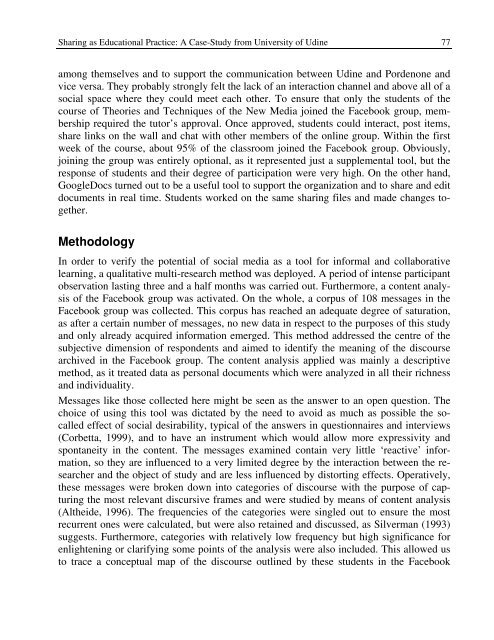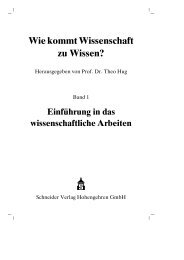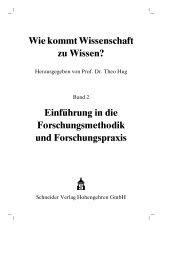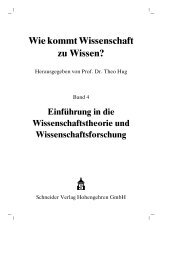Cultures and Ethics of Sharing - Universität Innsbruck
Cultures and Ethics of Sharing - Universität Innsbruck
Cultures and Ethics of Sharing - Universität Innsbruck
- Keine Tags gefunden...
Erfolgreiche ePaper selbst erstellen
Machen Sie aus Ihren PDF Publikationen ein blätterbares Flipbook mit unserer einzigartigen Google optimierten e-Paper Software.
<strong>Sharing</strong> as Educational Practice: A Case-Study from University <strong>of</strong> Udine 77among themselves <strong>and</strong> to support the communication between Udine <strong>and</strong> Pordenone <strong>and</strong>vice versa. They probably strongly felt the lack <strong>of</strong> an interaction channel <strong>and</strong> above all <strong>of</strong> asocial space where they could meet each other. To ensure that only the students <strong>of</strong> thecourse <strong>of</strong> Theories <strong>and</strong> Techniques <strong>of</strong> the New Media joined the Facebook group, membershiprequired the tutor’s approval. Once approved, students could interact, post items,share links on the wall <strong>and</strong> chat with other members <strong>of</strong> the online group. Within the firstweek <strong>of</strong> the course, about 95% <strong>of</strong> the classroom joined the Facebook group. Obviously,joining the group was entirely optional, as it represented just a supplemental tool, but theresponse <strong>of</strong> students <strong>and</strong> their degree <strong>of</strong> participation were very high. On the other h<strong>and</strong>,GoogleDocs turned out to be a useful tool to support the organization <strong>and</strong> to share <strong>and</strong> editdocuments in real time. Students worked on the same sharing files <strong>and</strong> made changes together.MethodologyIn order to verify the potential <strong>of</strong> social media as a tool for informal <strong>and</strong> collaborativelearning, a qualitative multi-research method was deployed. A period <strong>of</strong> intense participantobservation lasting three <strong>and</strong> a half months was carried out. Furthermore, a content analysis<strong>of</strong> the Facebook group was activated. On the whole, a corpus <strong>of</strong> 108 messages in theFacebook group was collected. This corpus has reached an adequate degree <strong>of</strong> saturation,as after a certain number <strong>of</strong> messages, no new data in respect to the purposes <strong>of</strong> this study<strong>and</strong> only already acquired information emerged. This method addressed the centre <strong>of</strong> thesubjective dimension <strong>of</strong> respondents <strong>and</strong> aimed to identify the meaning <strong>of</strong> the discoursearchived in the Facebook group. The content analysis applied was mainly a descriptivemethod, as it treated data as personal documents which were analyzed in all their richness<strong>and</strong> individuality.Messages like those collected here might be seen as the answer to an open question. Thechoice <strong>of</strong> using this tool was dictated by the need to avoid as much as possible the socalledeffect <strong>of</strong> social desirability, typical <strong>of</strong> the answers in questionnaires <strong>and</strong> interviews(Corbetta, 1999), <strong>and</strong> to have an instrument which would allow more expressivity <strong>and</strong>spontaneity in the content. The messages examined contain very little ‘reactive’ information,so they are influenced to a very limited degree by the interaction between the researcher<strong>and</strong> the object <strong>of</strong> study <strong>and</strong> are less influenced by distorting effects. Operatively,these messages were broken down into categories <strong>of</strong> discourse with the purpose <strong>of</strong> capturingthe most relevant discursive frames <strong>and</strong> were studied by means <strong>of</strong> content analysis(Altheide, 1996). The frequencies <strong>of</strong> the categories were singled out to ensure the mostrecurrent ones were calculated, but were also retained <strong>and</strong> discussed, as Silverman (1993)suggests. Furthermore, categories with relatively low frequency but high significance forenlightening or clarifying some points <strong>of</strong> the analysis were also included. This allowed usto trace a conceptual map <strong>of</strong> the discourse outlined by these students in the Facebook








